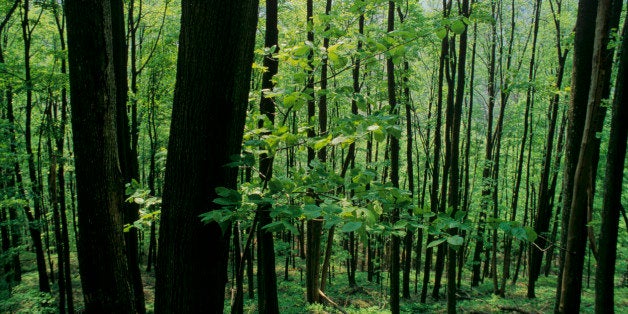
We're entering the home stretch of the adoption by the United Nations of new Sustainable Development Goals. The process to create these goals, which has brought governments, civil-society organizations, and communities from across the world together, will define the development targets that UN member states are expected to aim for over the next 15 years.
The result? Seventeen goals and 169 targets, covering everything from global health to urbanization to marine life. They represent impressive stakeholder input from thousands of global voices as part of the World We Want campaign. While these goals and targets are soon to be officially adopted, the question of implementation remains open. How are governments going to achieve so many targets?
The goal of protecting our ecosystem diversity is an achievable goal, with a path already paved. Scientists across the world have agreed that one of the best ways to protect our planet's diversity of plants and animals is to preserve large un-roaded areas and ensure such areas are connected to each other. Protecting and connecting intact forests, grasslands and deserts is especially important as our planet warms due to an increase of greenhouse gases from the burning of oil, gas and coal. Changes in climate are shifting plants and animals northward and higher up in elevation. If lands are not connected, they become islands, sentencing native plants and animals to wink out of existence as the planet warms.
Roads fragment habitat
Increasingly, we are seeing the fragmentation of once-intact habitats due to new roads. Roads bring in people and machinery, increasing wildlife collisions with vehicles, as well as an increase in soil erosion, especially in areas with little topsoil to absorb rains.
Google Earth Engine provides sobering satellite images of dramatic changes to the landscape from human activity. This time-lapse video, Amazon Deforestation, shows the impact new roads have on once untouched forests of the Amazon forest from 1984-2012. The development of new roads, among other things, open up virgin stands of trees to be cleared out for timber and cattle grazing. The result is not only denuded lands, but less trees to create oxygen and sequester carbon dioxide, further worsening climate change.
Here's how we can help change that.
Keep Large Areas Roadless
One of the more significant conservation victories in the United States was the establishment of almost 60 million acres of roadless areas in 2001 under the Clinton Administration. This designation declared that no new roads could be constructed on National Forests. These designated roadless areas are to be managed for wildlife conservation and watershed integrity, not for commercial logging, mining, or drilling. With almost 400,000 miles of roads crisscrossing America's National Forests, preserving and connecting these roadless areas is key to the future of wildlife in America. Intact forests also sequester millions of tons of carbon dioxide, and are an important solution to addressing climate disruption.
Reconnect Landscapes
Removing fencing and other barriers are critical to allowing wildlife to roam freely. Re-establishing connectivity across or below major roads allows wildlife to roam across historic ranges. On a recent visit to the Canadian Rockies, I was amazed to see a number of innovative wildlife bridges and tunnels cross over and under the four-lane highway. These bridges are being used by bear and elk, and have dramatically reduced the incidence of car-animal collisions that are fatal to animals and people. In Washington State, the Snoqualmie Pass along the major highway, I-90, just opened a new wildlife bridge, adding to a number of wildlife tunnels. This bridge re-connects two large National Forest areas and reestablishes hundreds of miles for migrating animals. And in Northern Montana, the People's Way Partnership stewards wildlife overpasses and tunnels on the Flathead Indian Reservation, ensuring moose, bear, bobcats, and other wildlife can safely cross I-93. In Southern California, support and funding is growing to put a wildlife overpass over Highway 101, which would allow mountain lions and other wildlife to safely move across the Santa Monica Mountain range.
In Europe, there are more than 600 wildlife bridges that have reconnected pockets of habitat once isolated by a web of roads, yet much remains to be done to reconnect lands critical to the future of many wildlife species on the brink of extinction. In Florida, car collisions remain the number-one killer of Florida panthers, an endangered species that is struggling to recover from the brink of extinction. In 2015 so far, car collisions have killed 17 panthers, or about 10% of the total population of these big cats. If these panthers are to recover, we must take action and educate the public.
If we are to protect and restore our world's wildlife, we must first protect unroaded areas and connect landscapes to allow wildlife the freedom to roam, find food and raise their young. Climate disruption continues to intensify.
As we move from global-goal setting to national and local implementation, there is much we can learn from the past. The Sierra Club is committed to not only reducing the amount of pollution in the air, but to also restoring and preserving our wild places.
We have accomplished a tremendous feat in agreeing to an ambitious set of global goals, but now is the time to roll up our sleeves. Ensuring sustainable development requires protecting, restoring and promoting sustainable forest management. If done right, we can reap great benefits for human, ecosystem, and planetary wellbeing.
This post is part of a series produced by The Huffington Post, "What's Working: Sustainable Development Goals," in conjunction with the United Nations' Sustainable Development Goals (SDGs). The proposed set of milestones will be the subject of discussion at the UN General Assembly meeting on Sept. 25-27, 2015 in New York. The goals, which will replace the UN's Millennium Development Goals (2000-2015), cover 17 key areas of development -- including poverty, hunger, health, education, and gender equality, among many others. As part of The Huffington Post's commitment to solutions-oriented journalism, this What's Working SDG blog series will focus on one goal every weekday in September. This post addresses Goal 15.
